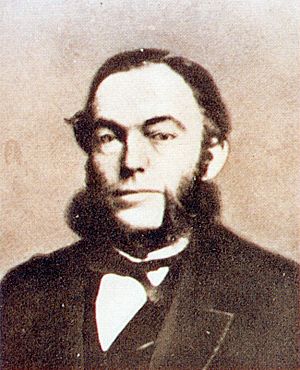Horatio Nelson Lay facts for kids
Quick facts for kids
Horatio Nelson Lay
|
|
|---|---|
 |
|
| Born | January 23, 1832 |
| Died | May 4, 1898 (aged 66) |
| Nationality | English |
| Occupation | diplomat |
Horatio Nelson Lay was a British diplomat who lived from 1832 to 1898. He is mostly known for his part in a project called the "Lay-Osborn Flotilla." This was a group of ships meant to help the Chinese government during a big rebellion.
Horatio Nelson Lay: A Diplomat's Story
Early Life and Work in China
Horatio Nelson Lay was born in Forest Hill, England. His father, George Tradescant Lay, was a naturalist and worked as a British consul in China. A consul is like a government representative in another country.
In 1847, young Horatio went to China to learn the Chinese language. He studied with a German expert named Karl Gützlaff. Horatio quickly became very good at Chinese.
Helping China's Customs Service
Because of his language skills, Horatio was promoted in the British consular service. In 1854, he became an acting Vice-Consul in Shanghai. The same year, he helped start the Chinese Maritime Customs Service. This service was important for managing trade and collecting taxes on goods coming into China.
The next year, Horatio became the first Inspector General of this new service. In China, he even adopted a Chinese name, Li Taiguo.
Role in the Treaty of Tianjin
During the Second Opium War, Horatio worked as an interpreter for Lord Elgin, a British diplomat. He helped with the talks for the Sino-British Treaty of Tianjin. This treaty was signed between Britain and China.
Horatio played a key role in these talks. He helped make sure the Chinese side signed the treaty, even though some parts were very difficult for China.
The Lay-Osborn Flotilla Project
Why China Needed Ships
During the Taiping Rebellion, a large uprising in China, the Chinese government wanted to take back control of Nanjing. Nanjing had been captured by the rebels. However, the government did not have enough ships to move troops or fight on the Yangtze River.
So, the Chinese government asked Britain for help. Britain agreed because they wanted to keep trade stable in China.
Planning the Flotilla
In 1861, the Chinese Emperor agreed to a plan to buy British gunboats. A British ambassador named Sir Frederic Bruce suggested this idea. Horatio Nelson Lay was chosen to be the Inspector General of this new fleet of ships.
Lay went to England to get the ships. Queen Victoria of Britain gave permission to prepare the vessels and hire crews. Lay then chose Captain Sherard Osborn to lead the flotilla.
Lay also designed a flag for the ships. This was because the Chinese government had not given clear instructions for a flag that would be recognized by other countries.
The Fleet's Journey and Problems
In February 1863, the "Lay-Osborn" flotilla, also called the "Vampire" Fleet, left England. It had seven steam cruisers and a supply ship. The ships arrived in China in September 1863.
However, problems quickly arose. Captain Osborn refused to take orders from local Chinese officers. He said his agreement with Lay meant he would only take orders directly from the Chinese Emperor, through Lay. The Chinese Imperial court did not agree to this.
Because of this disagreement, Osborn resigned in November 1863. He broke up the flotilla and sent the ships back to England. They never fired a single shot in battle. Horatio Nelson Lay was also removed from his position by the Chinese government that same year.
Later Life and Japanese Adventures
In 1864, Horatio Lay left his diplomatic job and went back to England. He then worked in financial matters.
Later, in 1869, the new government of Japan hired Lay as an advisor. He was meant to help Japan get its first loan from other countries. This money was needed to build Japan's first railways and telegraph lines.
Lay helped Japan get the loan, but his contract was later cancelled by the Japanese government.
Family Connections
Horatio Lay had several family members who also worked in the Chinese Maritime Customs Service. These included two of his brothers, two nephews, and one grandnephew. This shows a family connection to working in China's trade services.
Remembering Horatio Nelson Lay
A road in old Shanghai, near Yangtzepoo Creek, was once named Lay Road after Horatio Nelson Lay. This area is now part of Yangpu District. However, after 1949, the road was renamed Lanzhou Road.

